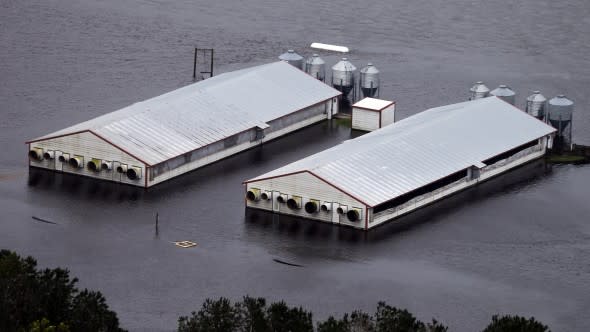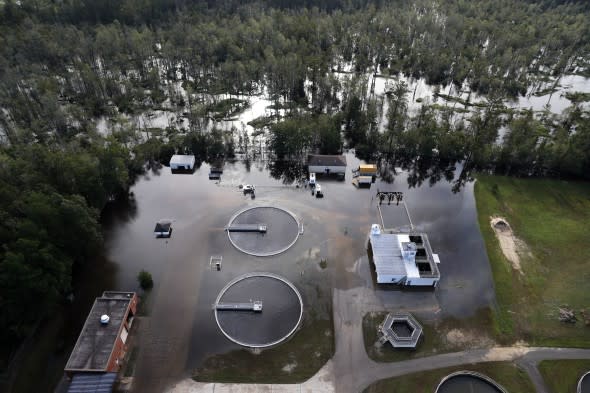600,000 customers warned of drinking water as North Carolina's flooded hog farms, waste lagoons under scrutiny for contamination
Prior to Hurricane Florence's arrival in the Carolinas, concerns were raised about the environmental and health risks of the storm. There was fear that torrential rain may flood power plants, industrial sites or animal-manure lagoons, causing toxic waste to threaten drinking water.
The storm has passed, leaving areas in its path flooded and devastated.
The rain left two dozen hog farms seeping waste, killed 3.4 million chickens and turkeys, caused widespread mandates to boil drinking water and kept workers trying to prevent coal ash waste from leaking out of a landfill, according to the Washington Post.

A hog farm is inundated with floodwaters from Hurricane Florence near Trenton, N.C., Sunday, Sept. 16, 2018. (AP Photo/Steve Helber)
North Carolina's vast hog farms and waste lagoons pose one of the greatest threats.
The North Carolina Department of Environmental Quality said Tuesday that it had received reports of floodwaters inundating or overtopping lagoons at 22 locations, leaving trails of floating excrement.
Four other lagoons suffered structural damage from floodwaters, the agency said. Fifty-five were at or near their capacity, the Post reports.
To help prevent a catastrophe, farmers took extraordinary measures in advance of Florence, such as moving thousands of animals out of harm's way as the hurricane approached.
"The storm's impact was felt deeply across a very large region, and the approximately 5,500 swine losses reported by the NCDA&S Emergency Programs and Veterinary Services divisions were the result of all aspects of the storm, including wind damage and flooding," the North Carolina Pork Council said in a statement on Tuesday, Sept. 18.
The council does not expect the losses to increase significantly, though floodwaters continue to rise in some locations and circumstances may change.
"Our farmers are working tirelessly now amid persistent and severe logistical challenges to continue the delivery of feed, to ensure power is operating on farms (as many use wells for water), and to reach the barns to provide proper animal husbandry," according to the statement.

A wastewater treatment plant is inundated from floodwaters in the aftermath of Hurricane Florence in Marion, S.C., Monday, Sept. 17, 2018. (AP Photo/Gerald Herbert)
The Environmental Protection Agency (EPA) said Monday that 16 community water treatment facilities in North Carolina are unable to supply drinking water and that seven publicly owned sewage treatment works are non-operational due to the flooding.
Utilities that serve more than 600,000 customers issued warnings to boil water before drinking it, according to state regulators in North Carolina.
Reggie Cheatham, director of the EPA's Office of Emergency Management, said Monday to ABC News that some sewage has been released into the floodwaters through sewer system manholes and a power failure at a water treatment plant in one case.
Cheatham told reporters some of the untreated sewage had been released into the Neuse and Cape Fear rivers.
Duke Energy is continuing cleanup operations Tuesday following a weekend breach at a coal ash landfill at its L.V. Sutton Power Station near Wilmington, North Carolina.
Duke Energy reported Saturday that about 2,000 cubic yards of coal ash, the equivalent of about 180 dump trucks, spilled out of a pond at an inactive power plant.
An EPA official said the material spilled into a ditch that fed into another pond of water but did not reach the nearby Cape Fear River, ABC News reported.
Coal ash is a byproduct of burning coal at power plants and contains toxic metals like mercury and arsenic. It can be toxic if it spreads to nearby bodies of water.
Environmental assessments are still underway at many of these potential hazardous sites. Environmental activist groups continue to sound the alarm on potential contamination.
